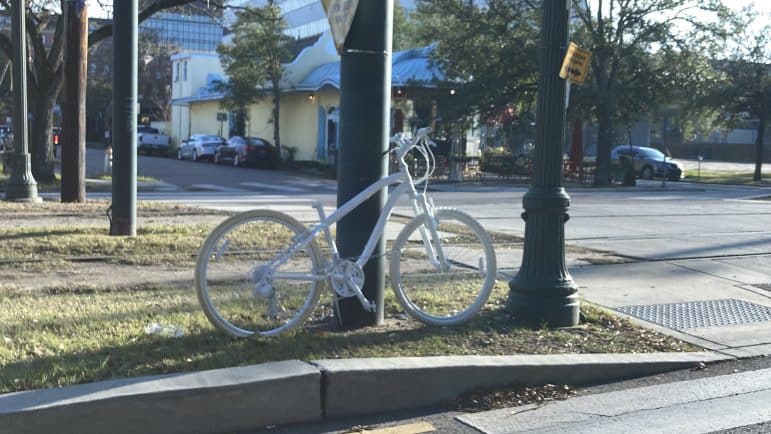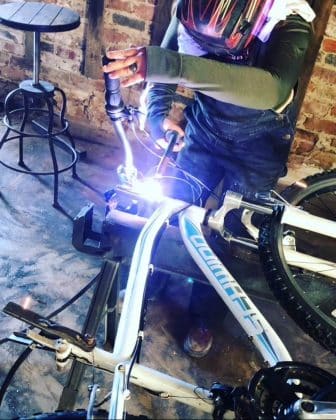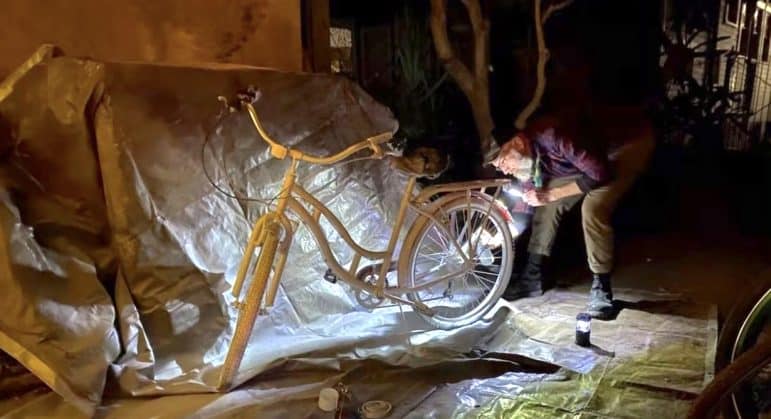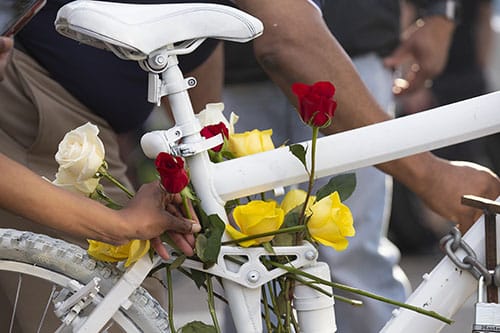
Uptown Messenger
The ghost bike on St. Charles Avenue and Delachaise Street, where a cyclist was killed Dec. 29.
Just days after the a cyclist was killed in traffic on St. Charles Avenue, a “ghost bike” was placed at the site to honor his memory.
There are a number of groups that make and place these ghost bikes (not to be confused with the Germany-based bicycle company of the same name) around New Orleans. This one was made by Angie Bailleux, who has been fabricating the bikes for going on five years.

Angie Bailleux fabricates a ghost bike.
Bailleux said she does not know the victim. In fact, his name and identity have not been released, so as of now the ghost bike for him is anonymous.
“This is a community effort,” Bailleux said. “The main thing is that we all participate in life itself, and in caring and honoring a person’s memory.”
The bikes are installed as soon as possible after the news of a cyclist’s death becomes known. As of this writing, there have been five bicycle fatalities in just the past three weeks.
Once a fatality is announced, the word goes out on Facebook, Instagram and other social media outlets and to bike shops that a donated “beater” bike is needed to create one of the identifiable white reminders.
Ghost bikes are installed not only in memory of the deceased, but as a reminder to motorists to watch out for cyclists and share the road safely.
They use damaged bikes, in some cases deliberately left twisted to create an effect. The parts are welded together to prevent vandalizing, painted white and chained to a lamppost or telephone pole near the accident.
Do they ever get removed? Yes, Bailleux said. They are especially vulnerable in locations where the city thinks tourists are likely to see them, she said.
But the ghost bike groups try to replace them quickly. They persevere even after multiple takedowns. Fabricators sometimes resort to placing the bike in the closest friendly spot, where a property owner has agreed to host the memorial.

A ghost bike is prepared for pubic display.
This practice isn’t limited to New Orleans. These striking reminders can be found nationwide and in more than 200 countries, with thousands of ghost bikes honoring fallen cyclists.
The ghost bike memorial project started in St. Louis, Missouri, in October 2003. After witnessing a fatal bicycle accident, cycling advocate Patrick Van Der Tuin placed a white-painted bicycle on the spot with a hand-painted sign reading “Cyclist Struck Here.”
Locally, once the victim’s identity is known, the group contacts the family so they will know their loved one has been honored and remembered. At the minimum, the person’s name is added to the bike. But in some cases, the families hold memorial ceremonies on site and add other items to the ghost bikes. Some get loaded with flowers and other tributes.

Zach Brien, MidCity Messenger file photo
Mourners place flowers on the ghost bike for Sharree Walls on Esplanade Avenue in 2019. (Zach Brien, Mid-City Messenger file photo)
Alex Fleming, a cyclist who has been involved in the ghost bike effort, is taking things a leap forward by starting a nonprofit organization, NOLA Ghost Bike Dedication Fund. The fund would help victims who survive bicycle accidents with medical expenses and help the families of those who are killed with funeral expenses.
He also emphasized the community effort and participation in the ghost bike memorials. “New Orleans has catching up to do with the rest of the country to become bike-friendly,” Fleming said. While the city has made steps in the right direction, too many streets have poor infrastructure, poor lighting, a lack of crosswalks and the like, he said.
“This winter is becoming the ‘winter of death’ with a record number of bicycle fatalities. It reminds me of the ‘summer of death’ in 2016,” Fleming said.
Biking has improved in New Orleans, with lower risks, but the city still has a long way to go, said Dan Favre, the executive director of Bike Easy. He cites the Dec. 29 fatality on St. Charles Avenue as underscoring the need for more connected bike paths.
“To avoid deadly crashes like this we need streets designed for all modes of transportation,” he said.
There are many people for whom bicycling is their only means of transportation – to work, to shop, to live everyday life. For those riders, as well as those who ride for fun, exercise and recreation, riding can be harrowing.
One Uptown resident who depends on her bike to get around told the Uptown Messenger that motorists do not respect bike lanes or look before opening their car doors onto a bike lane. Drivers not signaling is another big complaint among cyclists.
And she also echoed what Favre and Fleming said: The streets in New Orleans can be very unfriendly to cyclists. The potholes and the lack of infrastructure and connectivity of bike lanes all contribute to the injuries and fatalities.
The ghost bikes that populate the cityscape of New Orleans are a stark reminder that we do have a long way to go to ensure the safety of the city’s cyclists.
Ghost bikes are installed not only in memory of the deceased, but as a reminder to motorists to watch out for cyclists and share the road safely.”
I don’t understand this; the news write-up said the bicyclist didn’t obey the traffic signal. The ghost bike should be a reminder also to the bicyclists. I get around by bicycle only, or bus, and for years I have seen bicyclists coming through stop signs and red lights without checking for traffic, looking the wrong way crossing a one way. I object to nice car drivers trying to yield their right of way to me; I stop, put my feet on the ground, lose my momentum, curse a little until they conform to traffic regs; if they had kept their right of way, I could have gotten by with just slowing down.
But I resent the city ordinance forbidding use of turn signals. At least I think that must be the reason why cars almost universally don’t give turn signals except by the motion of the car.
I totally agree. I watched a cyclist pedal through a red light today on Magazine. He had no helmet.
Last night two people on bikes were riding against traffic. No helmet. No lights. Black clothes
I fully concur that the greatest dangers to cyclists are motorists swerving into bicycle paths in order to pass others on the right (illegally!), opening car doors without looking first, and drivers not signalling, particularly when making right turns across our paths.
I ride a tricycle, about 3 1/2 ft wide at the rear. My two most important safety features are a rear-view mirror and a flashing rear red light which I attached to the left side of my rear basket. I always use the light during the day. I can see cars and truck behind me, and I can see right-turn signal lights behind me. For the latter, I slow down and wave the motorist ahead.
I also stop (although I have the right of way) on Tchoupitoulas when a motorist is trying to make a left turn from or onto a side street. It’s a courtesy move, because I know how hard it is to get onto or off Tchoupitoulas when there’s no light.
Another horrible thing motorists do is blow their horns at us. Why? Are we doing something wrong? Why would they alarm us this way? What is their point, other than to harass us?
Heed this statement: Cyclists are required to follow ALL traffic laws designated for lawful driving. DO THAT, and you won’t get hurt or ticketed. Yes, I am the cyclist who yells at you when you BREAK the LAW: “Ya running a red light, idiot!” “One way street, stupid!” “Wrong side, ya fool!”
And don’t get me started on the family who not only ran the stop sign, but were pedaling the wrong way– with a little kiddo in a trailer. Of course, they didn’t see the stop sign, because it was on the other side of the intersection. I witnessed this the day after the cyclist on Delachaise was killed while barreling out into traffic. The dead cyclist on St Bernard was on the incorrect side of the street.
Dan Favre pops up everywhere, even on City Committees, making frequent use of hyperbole to shape public opinion towards his own paid advocacy efforts. He is quoted here as saying. “There are many people for whom bicycling is their only means of transportation – to work, to shop, to live everyday life.” This is not actually true. People can walk. They can take the RTA buses and streetcars, even the ferry. Some use power wheelchairs and scooters, and handicapped transport services. The elderly get free transportation for medical appointments through their health insurer. Most people at least occasionally get rides from friends, neighbors, relatives. There is literally NOBODY who can only use their bicycle as a means of transportation. In fact, the heat, rain, injuries and hurricanes here mean that bicycles cannot actually be depended on as the only means of transport, all cyclists who commute must have a backup plan.